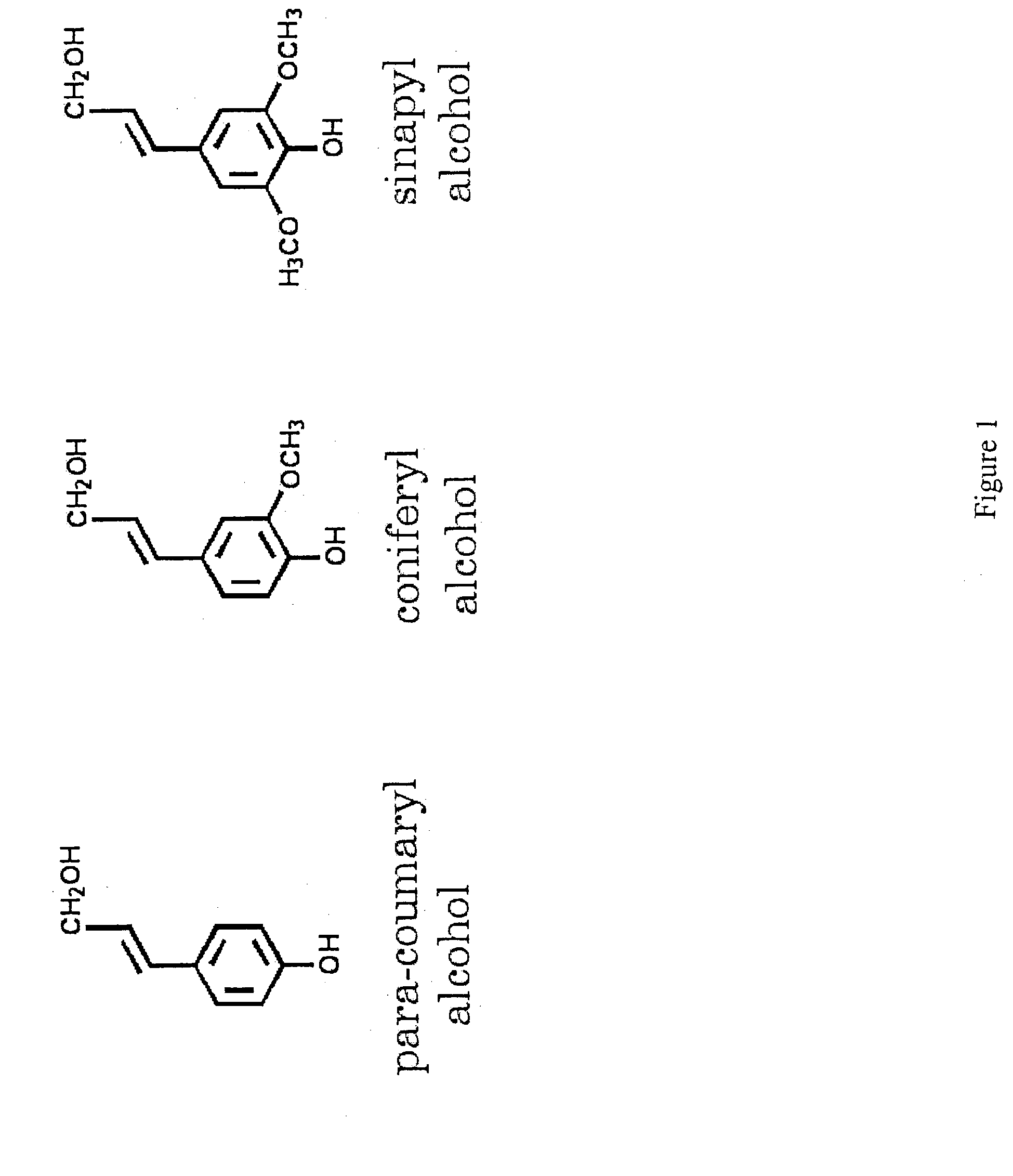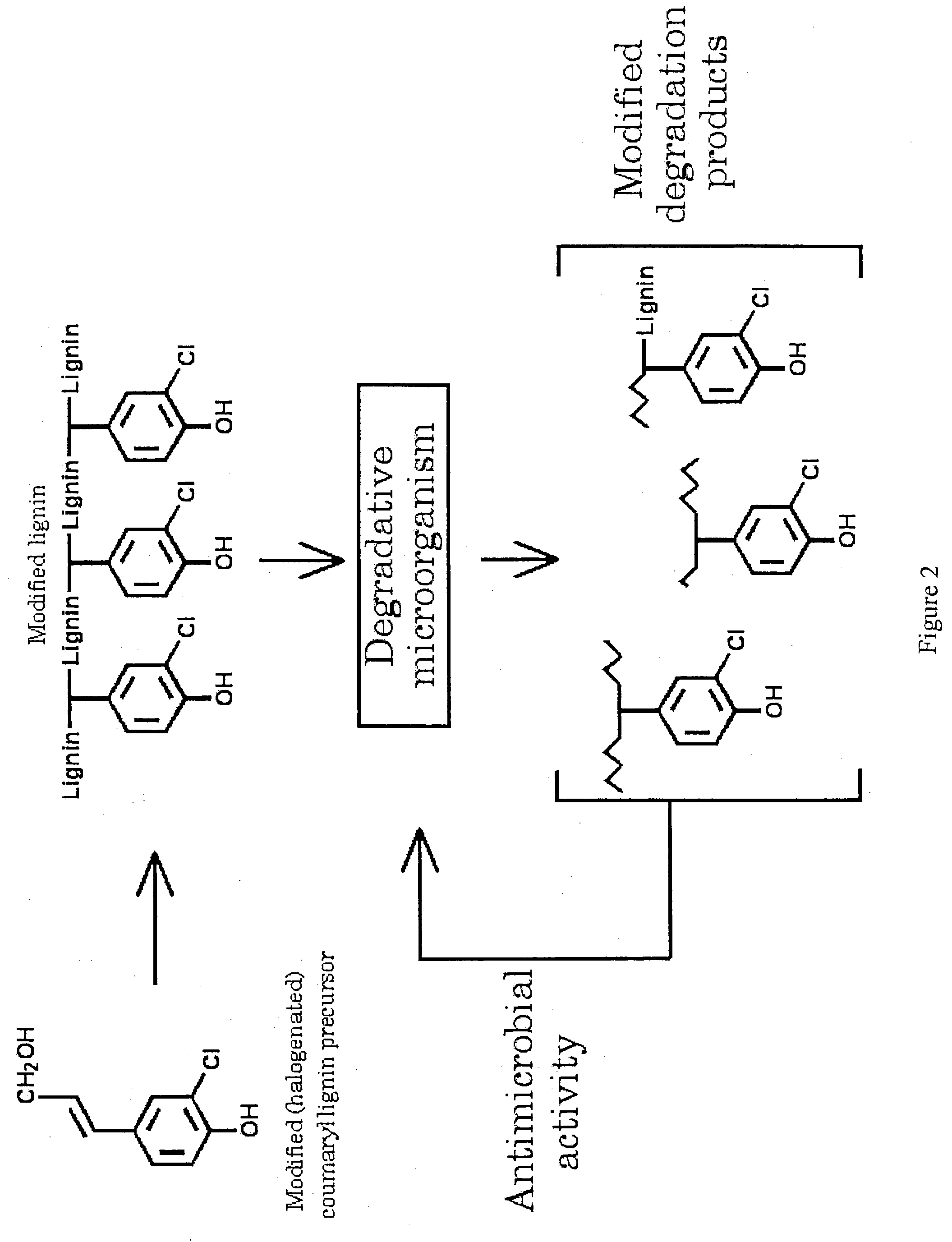Plant preparations
a plant preparation and plant technology, applied in the field of plant preparations, can solve the problems of increasing carbon dioxide levels, global warming and fluctuations, and simultaneously being very difficult to degrade, and achieve the effects of enhancing the antimicrobial properties of lignin degradation products, and reducing the rate at which plant biomass decays
- Summary
- Abstract
- Description
- Claims
- Application Information
AI Technical Summary
Benefits of technology
Problems solved by technology
Method used
Image
Examples
example 1
plant materials
[0168] (i) Sugar cane: Saccharum officinarum L.: cv. B4362
[0169] Plants were cultivated in a greenhouse environment and modified precursors were applied via drench application to the roots. Prior to harvest plants were held in the dark for three days to reduce the starch content. Mature stalks were harvested, crushed, extracted and washed to remove the sugar and soluble materials. Bagasse was produced from the washed remaining solids for treatment and for subsequent staining and observation. Observations were made with a dissecting or a light microscope.
[0170] The production of bagasse is a routine procedure, well known to those in the art. Nevertheless, a short description of the method employed by the inventor follows. Approximately 50 g of sugar cane stalks were homogenized in a standard blender in approximately 4 to 5 volumes of water. The fibrous material obtained was strained and filtered, for example through cheesecloth, and the resultant material washed twice ...
example 2
Microbial, Soil and Chemical Materials
[0173] (i) Microbial Materials
[0174] Phanerochaete chrysosporium, a lignin degrading fungus, was maintained on potato dextrose agar (PDA). Lignin degradation studies employed culturing the fungus in a liquid mineral salt medium that contained treated plant materials, such as bagasse from a plant that had been treated with a modified precursor preparation. The bagasse in the medium comprised the sole source of organic carbon for support of fungal growth. One inoculum "loop," a standard tool used in the preparation and culturing of microbes, was used to inoculate the medium.
[0175] Pseudomonas putida, a soil bacteria with wide catabolic capabilities, was maintained on nutrient agar. Minimal Inhibitory Concentration studies employed a mineral salts medium supplemented with 1% dextrose and 0.1% yeast extract. One inoculum "loop," a standard tool used in the preparation and culturing of microbes, was used to inoculate a plant sample. (ii) In Situ Soil...
example 3
Staining Methodologies
[0180] Techniques are described herein for treating thin, hand cut plant sections to estimate the amounts of plant polymer materials, such as lignin, and of fungal cell wall materials, such as chitin, in and around those plant sections.
[0181] Staining intensity ratings were subjectively established on ten-point rating scales and used as qualitative rankings within each individual example. Unless otherwise indicated, staining for lignin present in bagasse was performed by both the phlorgluciol and hypochlorite / sulfite techniques and was rated subjectively on a ten-step scale, from most intense staining (9) to no staining (0). Staining for chitin present in the bagasse was also subjectively rated on a ten-step scale from most intense staining (9) to no staining (0). All staining techniques were performed in triplicate, unless otherwise indicated. Thus, a high lignin stain and low chitin stain recovered from a treeated plant sample indicates that there are few mic...
PUM
| Property | Measurement | Unit |
|---|---|---|
| Color | aaaaa | aaaaa |
| Electrical resistance | aaaaa | aaaaa |
| Fungicidal properties | aaaaa | aaaaa |
Abstract
Description
Claims
Application Information
 Login to View More
Login to View More - R&D
- Intellectual Property
- Life Sciences
- Materials
- Tech Scout
- Unparalleled Data Quality
- Higher Quality Content
- 60% Fewer Hallucinations
Browse by: Latest US Patents, China's latest patents, Technical Efficacy Thesaurus, Application Domain, Technology Topic, Popular Technical Reports.
© 2025 PatSnap. All rights reserved.Legal|Privacy policy|Modern Slavery Act Transparency Statement|Sitemap|About US| Contact US: help@patsnap.com



